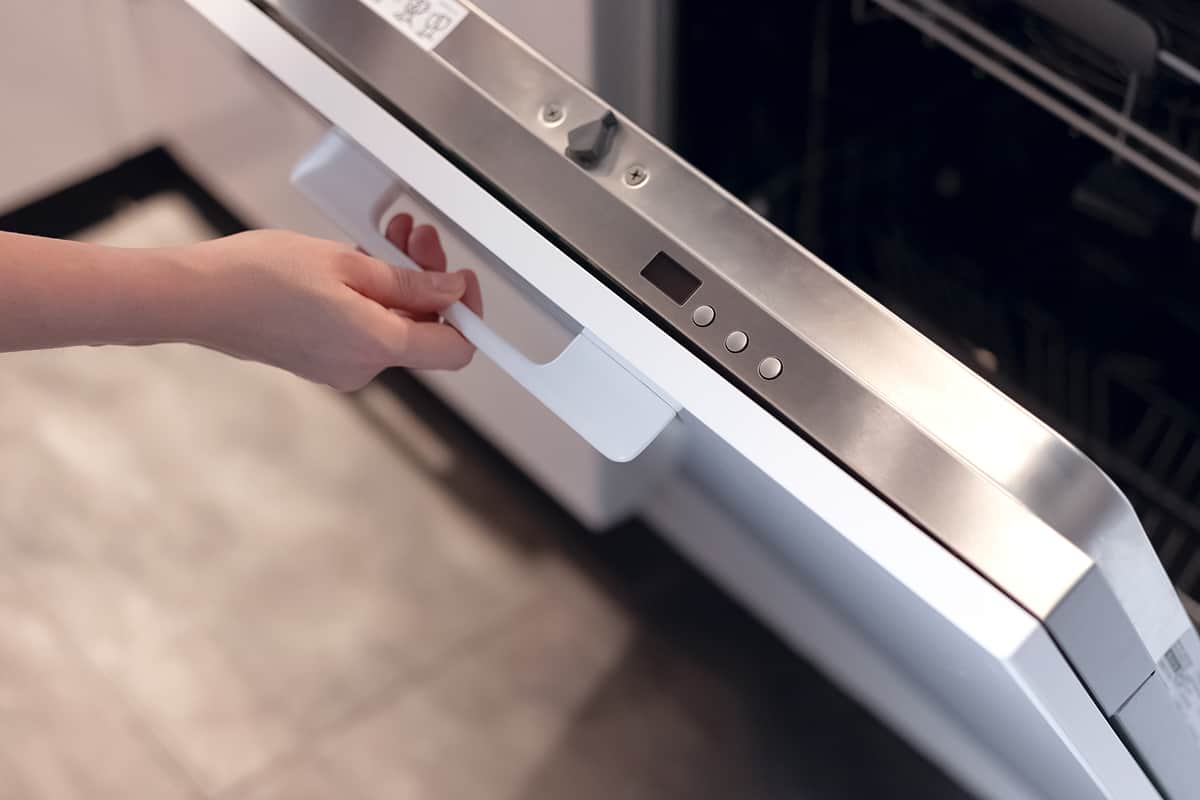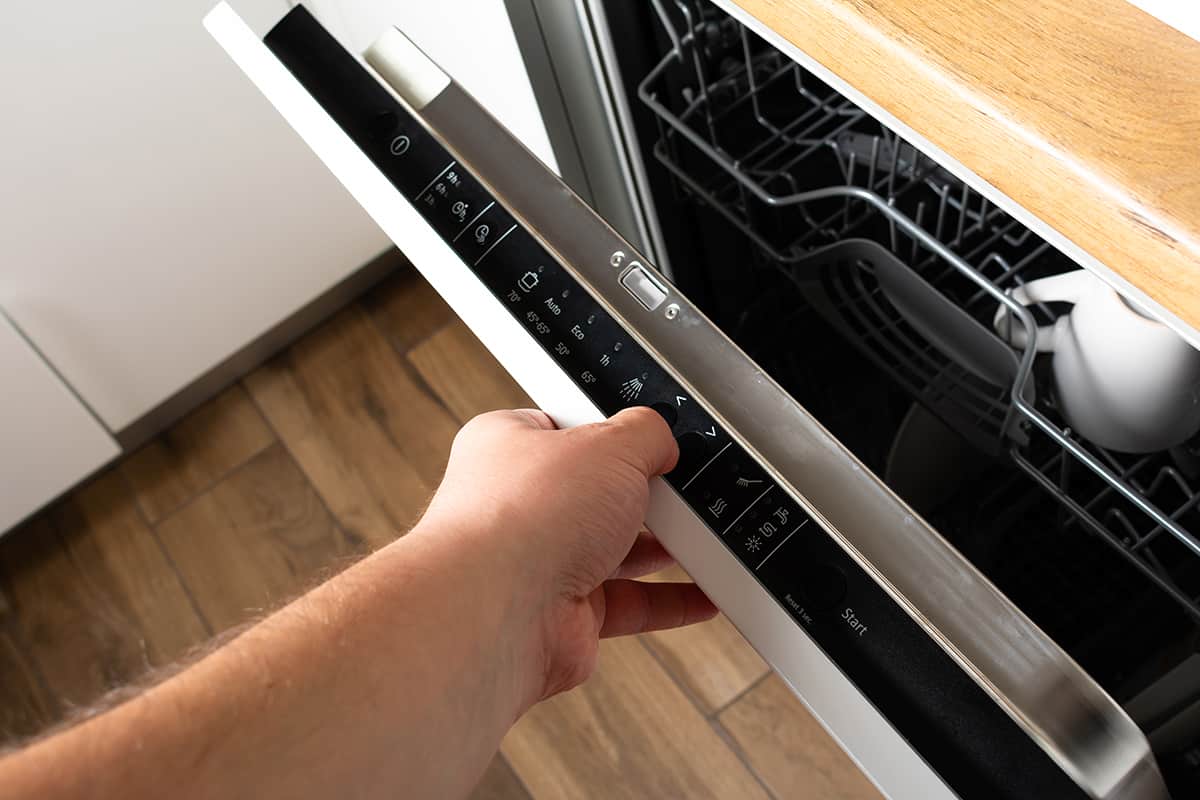The door latch on a dishwasher does more than keeping the door in place in order to prevent water from leaking out.
Your dishwasher’s control board will not work properly if it does not register a shut door, and a door can only be shut if the door latch is in working order. So, what should you do to fix the door latch on an Amana dishwasher?
If your Amana dishwasher’s door latch doesn’t seem to be functioning properly, here’s what you need to do:
- Cut the power to the dishwasher
- Check the door latch
- Check the door latch’s rotation
- Check the strike plate
- In extreme cases, you might have to replace the door latch entirely.
In this guide, I’ll explain the steps to fixing an Amana dishwasher door latch in greater detail, as well as discuss why door latches fail in the first place and how to tell when the door latch needs to be replaced.
How to Fix an Amana Dishwasher Door Latch (Step-by-Step)
Amana dishwashers are not “bad” by any stretch of the imagination. Just like other dishwashers, they spray water at your dishes, introduce a healthy amount of suds, and rinse the soap and debris off. However, as time goes on, your Amana dishwasher might experience minor mechanical problems.
One of the most common problems you might come across, especially if your Amana dishwasher is older than three years, is a faulty door latch. Over time, moisture, food particles, and grease might find their way into the door latch and prevent it from keeping the door shut completely. And when this happens, your dishwasher becomes one heavy, expensive paperweight.
But worry not, friends, for I’ve come to explain the steps on how to fix an Amana dishwasher door latch in just four easy-to-follow steps!
But before we begin, make sure you have the following tools on hand:
- Screwdriver
- Needle-nose pliers
- Pencil or a long, thin poking object
- Small brush
Step 1. Cut the power to the dishwasher
It’s important to note that checking on the door latch requires a bit of disassembly. So, before doing anything, cut the power to your dishwasher. Simply turn the dishwasher off (if it’s still on) and unplug the power cord.
If your dishwasher is hardwired, flip the circuit breaker that delivers power to your dishwasher. Press the buttons on the dishwasher control board to ensure that the machine is completely devoid of power.
Step 2. Check the door latch

To check the door latch, open the dishwasher door all the way. Now, use the screwdriver to unfasten the screws that connect the inner-front panel to the outer-front panel of the dishwasher’s door to expose the door latch. It can be found at the center of the top of the door.
Now, using a finger or a long object like a pencil, press the microswitch. If pressing the microswitch doesn’t cause it to react in any way, there might be old food particles in the way.
With the small brush, gently brush away any solid debris you find inside the latch mechanism. You can also slightly moisten the bristles to help loosen caked-on debris.
If removing solid particles from the latch mechanism doesn’t restore the microswitch to a working state, move on to the next step.
Step 3. Check the door latch’s rotation
There are certain Amana dishwasher models whose latch mechanism uses a pivot pin. This means that the latch rotates rather than moves vertically to grab onto the strike plate to keep the door shut. If your dishwasher uses a rotating latch, solid debris may be hidden within the rotating path.
The simplest way to remove dirt and debris from a rotating latch is by spraying it with WD-40 or another lubricant for metal. Spray a generous amount of the lubricant inside the latch while also using a pencil to continuously rotate the latch in place.
Step 4. Check the strike plate
The strike plate is the component that the door latch connects to. It can be found near the front of the dishwasher. When it comes into contact with the latch, the latch should immediately hook around it and produce a slight snapping sound.
If it doesn’t, look for a misaligned strike plate or other abnormalities in its shape. If it has been shifted in any way, the door latch might not loop around it, which can cause your dishwasher not to register a shut door. You might need to use your needle-nose pliers to encourage the strike plate to return to its original place.
Why Do Dishwasher Door Latches Fail?

There is a multitude of reasons why your dishwasher’s door latch might not be in a working state. I’ll describe some of the most common causes down below, as well as what you can do to prevent them from occurring.
Shutting the door too hard—Have you ever slammed your dishwasher’s door shut? If so, that might be the root problem for why the latch is malfunctioning. The latch can only take so much abuse before it begins to shift out of position or even fall apart.
Whenever you want to shut the dishwasher’s door, do it gently, and make sure you utilize the child safety lock to stop your kids from destroying the door and door latch.
Constant moving—This is mainly an issue for those with freestanding portable and countertop portable dishwashers.
Constantly moving the dishwasher around and lifting it can cause the strike plate to move out of position. So, find a spot in your kitchen for the dishwasher and leave it in place. If you have to winterize the dishwasher, move it as little as possible.
Excess moisture—Whenever you open the dishwasher door after a cycle has completed, steam will immediately begin pouring out, and some of it might get stuck in the latch mechanism.
A little bit of moisture isn’t an issue, but over time, the water vapor might cause the latch, microswitch, or strike plate to rust. So, after a wash cycle, leave the door slightly ajar to allow steam to vent upward and evaporate from inside the latch.
Residue buildup—A buildup of solid debris isn’t uncommon in the latch mechanism, especially if the spray arms deliver tons of pressure and cause soap and food remnants to fling all over the place.
To prevent residue from building up in the door latch, scrape off as much food from your dishes as possible before placing them on the dishracks.
Do I Need to Replace the Door Latch?
Sometimes, the damage to your dishwasher’s door latch might be beyond reparable; in which case, you will have to swap it out for a brand-new latch.
For the most part, there are only two telltale signs that you need to replace the latch: broken parts and rust.
Other symptoms of a faulty latch, including a misaligned strike plate or a stuck latch, can be fixed by following the steps provided above.
Luckily, replacement latches for Amana dishwashers aren’t too expensive. You can pick up a brand-new replacement for between $25 and $50. Just make sure that you get a latch that is compatible with your exact Amana dishwasher model.
When in doubt, consult the owner’s manual to see what model you have before reaching out to the manufacturer to see whether or not they have replacement latches on hand. You might also want to consult a professional repairman to see whether or not your existing latch is salvageable.






